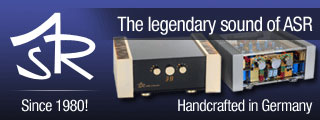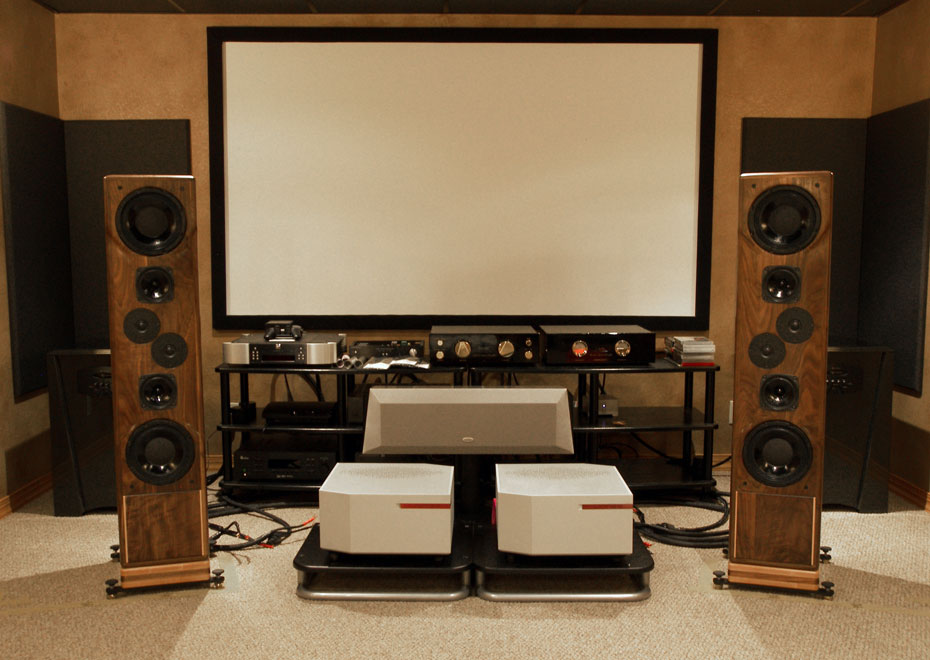Sensation of Increased Definition
I say “sensation” since I have no official testing to demonstrate it is so. I received strong sensory input that the Midrange and Bass especially were profoundly improved by the Landscape position. I prefer the Ulysses in overall clarity, definition and transients when in Landscape mode, as it becomes a super-wide super-monitor.
One of the most striking results of moving the speaker sideways was elimination of a strong floor bounce from the bass. I had no clue how profoundly the speaker was being negatively influenced in the bass performance until I turned it away from the floor. This was not a room issue. If anything the bass floor bounce was weakened by the cement basement floor covered by ½” padding and a thick Berber carpet. I tend to seek all drivers firing at me, not away from me. My rule is that any deviation from directly firing at me means the speaker will suffer proportionately lower resolution and the speaker’s performance spectrum will suffer accordingly. Even subwoofers sound cleaner when fired directly at the ear, as I point out in the upcoming Legacy Audio XTREME HD review. Blasting a bass driver into the floor is acceptable to the community, but I wonder why? Because it is accepted by the community seems to be the answer. There are many manufacturers who might have interest in Landscape speakers but will not touch the idea because the audiophile community is not terribly experimental.
Since so many listening rooms are also living rooms or patrolled by décor police it just isn’t done. I know my wife would not be happy if I put the Ulysses on their sides in our living room. Thankfully I have a dedicated room and her attitude is, “It’s his room, he can do what he wishes.” It’s not worth fighting with the wife to put the speakers on their sides, manufacturers, distributors and dealers know such a display would not sell well. Nevertheless, interior design doesn’t overshadow in home speaker performance, while set up and placement does.
What of bass driver interaction with side walls? In my case there was far less of it due to strong toe in and walls properly built for an audiophile room. The speakers were angled in away from the room boundaries more than if they were in Portrait perspective. Getting the speaker off the floor was the key to transforming the bass, and it was refreshing to hear unencumbered 8” drivers. Whatever interaction there was between wall and speaker was minimal compared to the damage inflicted by the floor bounce. In addition, one can add sound panels near the speakers along the walls to tame perceived reflection anomalies.
A low ceiling can cause fits for an audiophile. Especially if you struggle with a low ceiling consider Landscape speaker positioning. My ceiling is 7.5’ high, but it doesn’t present problems as it is custom with a solid under-ceiling beneath. Moving the mains to a horizontal attitude can resolve ceiling reflections. You may have a ceiling bounce which could be ameliorated by Landscape perspective.
Superior Left/Center/Right Separation and Integration
Again, while listening to speakers in the Landscape orientation the distinct impression is that not only is the soundstage stretched to its full sideways limit, but that in Portrait orientation it is compressed. The openness of the Landscape mode is addictive every bit as much as a panel speaker’s “wall of sound,” or an omnidirectional speaker’s holographic imaging. Is it perfect? No more than a dynamic speaker in Portrait perspective, or a panel, or an omnidirectional. But it is different enough that it is immediately captivating and worth utilizing. Regardless of what anyone else thinks I will be using these speakers in this fashion in my room.
One of the most compelling reasons I will continue to use the Landscape mode with the Ulysses is for the remarkable Left/Center/Right separation and integration. As a prism refracts light, so also the Landscape perspective “refracts” the audio spectrum allowing more elements of the music to be distinguished clearly. A rainbow is white light teased apart, yet is still a unity. Similarly, the Landscape mode teases apart the audio signal, seemingly sending increased information to the Left and Right channels, even though nothing has changed in terms of the signal path. Discrete elements of the music arrive at the ear more deliciously spaced, similar to the presentation of a dinner plate at a fine dining establishment. Some musical elements appear at the respective speakers, but others appear clearly between Left, Right and the Center image. Whereas in Portrait perspective three loci of sound exist, with the Landscape perspective five exist, the two additional being between Left and Center, and between Right and Center.
The additional musical artifacts are not divorced from the unity, but rather like the prism seen as compositional to it. There are aspects of IMAX theater screens I greatly dislike as they are bulbous and have warped perspective, like a fisheye lens, but the experience is thrilling! My ear does not perceive the Landscpape positioning as a skewed IMAX screen, but rather as a widescreen cinema, a much more natural sensation. In this position the ear seems to take in more information, resulting in a very pleasurable enjoyment of the performance of instruments, voice bands and even an entire live venue.
Objections
Whenever I try something new which is potentially perceived as odd or of marginal merit I anticipate that some will mock the idea, others will be confused and yet others will object on the logical basis that if it were any good it would already be commonplace.
Speaking to the “commonplace” objection, because of the previous stated limitations I don’t believe the Landscape perspective for speakers will ever gain ascendancy over Portrait positioning. However, technology and knowledge have a tendency to alter what is considered normal. If enough people try the new form it is a bit less uncommon. Always following convention in establishing two-channel systems is not my idea of fun. I love the varying forms of technology and systems and want to manipulate them into novel arrangements. It is one way to have ear-opening experiences, sometimes at little additional cost which is always a bonus!
Mockers who wish to insult and refuse to discuss intelligently I simply ignore.
Those who are confounded may not be able to envision the result or have concerns about things such as four Midrange drivers at ear level. As I set up the Landscape orientation I wondered if the array of drivers at ear level would sound messy. In fact, it is no more “messy” than placing the speakers in Portrait mode. Portrait mode presents its own issues including a pronounced “floor bounce” from the lower bass driver, and the ever present difficulty of finding a perfect balance between an expansive soundstage and a finely focused center image. If one is attuned to speaker driver coherence the multiple drivers of any multi-way speaker can usually be heard. For some that is a big problem, so they will only accept a single point source speaker, in other words a speaker which either has a single driver or imitates having a single driver. If that is not a show-stopper for you the Ulysses and similar tower speakers can offer their level of coherency either upright or sideways.
In terms of the acquisition of an ideal center image and gloriously wide soundstage it has been my experience that one cannot have both to ultimately satisfying degrees simultaneously; there must be compromise in either or both aspects. However, there needs be no compromise in terms of center imaging and wide soundstage when in Landscape orientation. To be fair, with the more compressed vertical soundstage some may find that this is intolerable, however I do not believe it would be to any degree more extreme than the horizontal soundstage is compressed when the speakers are upright. Both options can be tweaked but neither executed perfectly to its full potential in both aspects.
More experimentation to come
I do not believe I have exhausted all my thoughts on the matter of Landscape setup of the Ulysses, but I will draw to a close for now. I will be continuing my exploration of this topic with other speakers, such as the aforementioned Legacy Audio Marquis Center Channel, and plan to give updates periodically. This article may be considered a first report of a long term study. How far it will take me, I have no clue. I do not expect it to win any awards or bring neophytes into the audiophile fold, but I do hope a few intrepid souls try it and find they are having a great time! Perhaps for some it will be their “WIA System” – which stands for Wife Is Away!
I thank Lou Hinkley at Daedalus audio for using his wits to make the lovely Ulysses, and unwittingly making it amenable to such multi-faceted system development. Putting together systems with the Landscape method has opened a larger “widescreen” window onto the world of music. I plan to sit for a long time and peer through that window!
Associated Components:
Source: Simaudio Moon Evolution 750D DAC/Player; Cambridge Audio 840C; Denon 2900 Universal Player; Sonos Digital Music System; Oppo DV-970HD
NAS: Buffalo Linkstation 500G
DAC: Eastern Electric Minimax DAC Plus with Burson and Dexa NewClassD Discrete Opamp Upgrade
Preamp: VAC Renaissance Signature Preamplifier MkII; Purity Audio Design Silver Statement; Cambridge Audio 840E
Amps: VAC Phi 200; Pass Labs XA160.5 Monos; Jones Audio PA-M300-1-2 Monoblocks; Cambrige Audio Azur 840W
Integrated: Pathos Classic One MkIII stereo tube hybrid (two units bridged to mono); Peachtree Audio Nova
Speakers: King’s Audio Kingsound King; Kings Audio Kingsound King III; Legacy Audio Whisper DSW “Clarity Edition”; Kings Audio King Tower Omnidirectional; Eminent Technology LFT-8b
Subwoofers: Daedalus Audio BOW
Interconnects: Clarity Cable Organic RCA/XLR; Tara Labs RSC Air1 series 2; Wireworld Equinox; Wireworld Silver Eclipse; Wireworld Platinum Eclipse
Speaker Cables: Clarity Cable Organic Speaker; Tara Labs RSC Air1; Wireworld Equinox 5; Wireworld Silver Eclipse
Digital Cables: Clarity Cable Organic Digital; Tara Labs RSC Air 75; Wire World Startlight 6; Wireworld Gold Starlight 5, Wireworld Gold Starlight 6
Power Cables: Clarity Cable Vortex; MIT Oracle ZIII; Tara Labs RSC Air; Xindak PF-Gold; Wireworld Stratus 5, Electra 5 and Silver Electra
Power Conditioning: Wireworld Matrix Power Cord Extender; Tara Labs ISM Power Screen; Tice Audio Solo
- ← Previous page
- (Page 3 of 3)



Hi Doug,
Fascinating read. Have you ever tried just listening to mono over one speaker. I am currently listening
to mono (mono switch on preamp) to a single 1.4 magnepan speaker. It sounds fabulous and sort of
similar to your landscape orientation of stereo. Any thoughts.
Shaun,
God’s Joy to you,
Thanks for the comments, I appreciate them! I have not tried a mono recording on one speaker. I just recently was comparing a mono recording to the stereo recording and it is striking how much information in what we perceive as music well done is a result of the stereo recording process.
I have also conducted Landscape Orientation exercises with the Magnepan .7 and Pure Audio Project Trio15 Horn 1 speakers. The PAP Horn 1 is by far the most extreme and pleasing of all three speakers I have tried in Landscape orientation.
Blessings,
Douglas Schroeder